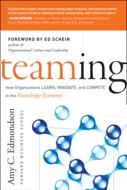# Teaming

## Metadata
- Author: [[Amy C. Edmondson]]
- Full Title: Teaming
- Category: #books
## Highlights
- Teaming behavior is often at odds with the demands of formal organizational structures, which divide people by specialty and focus more of their attention on bosses than on peers.
- Framing is a crucial leadership action for enrolling people in any substantial behavior change.
- conflict is viewed as a competition to be won rather than a problem to be understood and solved.
- A promotion orientation is characterized by ideals, goals, and eagerness to attain them. It reflects a tendency to frame new situations in terms of what can be gained. Conversely, a prevention orientation is characterized by a sense of obligation and by vigilance against loss. It indicates an inclination for framing new situations as opportunities to lose ground.9
- organizational researchers have shown that leaders can frame, or reframe, a situation in ways that powerfully influence how others respond to, or engage in, the situation.
- In the learning organization, problems and errors must be reported so everyone can learn. Flawless performance means not stretching enough.
- celebrate the disruptive questioner who simply won’t leave well enough alone.
- That, in turn, means that managers as individuals no longer know enough to make decisions and get things done
- The most obvious limitation to this formula is that the changing nature of complex tasks makes it difficult to decide ahead of time what personal style and competency set to measure. Secondarily, it will be more and more difficult to find and recruit whatever competence may be needed.
- What this book emphasizes so well is that the mindset of teaming has to be focused on how to get the job done with the team resources available, and that inevitably is a learning process.
- Tags: [[pink]]
- collective learning—that is, learning in and by smaller groups—is regarded as the primary vehicle for organizational learning
- Tags: [[pink]]
- Teaming, coined deliberately to capture the activity of working together
- Tags: [[pink]]
- teaming calls for developing both affective (feeling) and cognitive (thinking) skills
- Tags: [[pink]]
- conditions
- Tags: [[pink]]
- teaming—taking risks, confronting failure, and crossing boundaries
- Tags: [[pink]]
- Crucial learning activities must take place, within those smaller, focused units of action, for organizations to improve and innovate.
- Tags: [[pink]]
- complex adaptive system
- Tags: [[pink]]
- Complex adaptive systems self-regulate. Not always in preferred ways, mind you, but they change in response to both external and internal triggers
- Tags: [[purple]]
- When people must be able to shift from one situation to another while maintaining high levels of communication and tight coordination. This situation literally defines the practice of teaming.
- Naïve Realism
- We are all prone to naïve realism, a term coined by psychologist Lee Ross, which is a person’s “unshakable conviction that he or she is somehow privy to an invariant, knowable, objective reality—a reality that others will also perceive faithfully, provided that they are reasonable and rational.”13 So, when others misperceive our “reality,” we conclude that it must be because they are unreasonable or irrational and “view the world through a prism of self-interest, ideological bias, or personal perversity.”14 And therein lies the trouble.
- ambiguous situations, conflicting interpretations of the same facts were used to fuel conflicting truths
- Task and Relationship Conflict
- Task conflict—a difference of opinion about the product design—is useful. Relationship conflict—personal friction or emotionality—is counterproductive and should be avoided
- Tags: [[pink]]
- Task conflict—a difference of opinion about the product design—is useful. Relationship conflict—personal friction or emotionality—is counterproductive and should be avoided.
- Tags: [[pink]]
- leadership is needed to help groups build shared understanding and coordinate action.
- Tags: [[pink]]
- Exhibit 2.3: Leadership Actions for Organizing to Learn
Action 1: Frame the situation for learning.
Action 2: Make it psychologically safe to team.
Action 3: Learn to learn from failure.
Action 4: Span occupational and cultural boundaries.
- Tags: [[pink]]
- How Management Teams Can Have a Good Fight,” Harvard Business Review 75, no. 4 (1997): 77–85.
- Tags: [[pink]]
- Therefore, effectively framing a task involves providing a compelling answer to the question of why a particular project exists. What purpose does it serve?
- Tags: [[pink]]
- Leaders who frame themselves as interdependent with others in accomplishing important changes, view others as crucial partners, and put forward an aspirational purpose are employing a learning frame
- Tags: [[pink]]
- In promoting teaming and learning, framing is a good place to start
- Tags: [[pink]]
- Just as cognitive psychologists have identified habitual differences across individuals in framing, and behavioral therapists have described ways to help individuals reframe to improve their emotional and psychological health, this chapter emphasizes the power of leaders. Leaders of teams that are responsible for new initiatives are uniquely placed to influence how others see the project, especially how they view its purpose, and how they see their own role in achieving that purpose.
- Tags: [[pink]]
- three dimensions of framing—the leader’s role, others’ roles, and the project purpose
- Tags: [[pink]]
- framing their role, leaders must explicitly communicate their interdependence and express both their own fallibility and the need for collaboration.
- Tags: [[pink]]